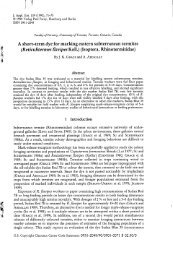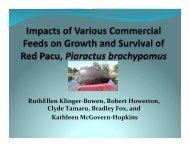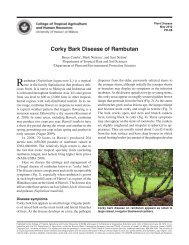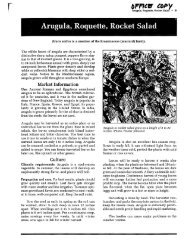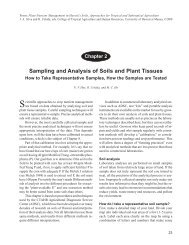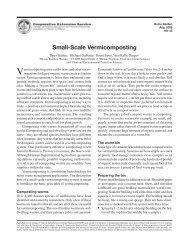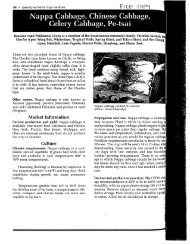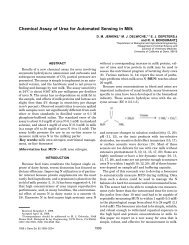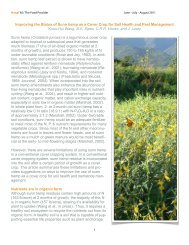New protea cultivars for Hawaii growers from the University of ...
New protea cultivars for Hawaii growers from the University of ...
New protea cultivars for Hawaii growers from the University of ...
You also want an ePaper? Increase the reach of your titles
YUMPU automatically turns print PDFs into web optimized ePapers that Google loves.
<strong>New</strong> Protea Cultivars <strong>for</strong> Hawai‘i Growers<br />
<strong>from</strong> <strong>the</strong> <strong>University</strong> <strong>of</strong> Hawai‘i<br />
Protea Research Project—1999 to 2004<br />
K. W. Leonhardt, P. Shingaki, P. Nakao, T. Jewell, T. Miguel, and D. Oka<br />
Department <strong>of</strong> Tropical Plant and Soil Sciences<br />
The rich diversity <strong>of</strong> <strong>the</strong> Proteaceae family has infused<br />
<strong>the</strong> floriculture industry worldwide with<br />
unique, dramatic new products. With more than 1400<br />
species in 60 genera, <strong>the</strong> <strong>protea</strong> family is still largely<br />
unexploited in terms <strong>of</strong> commercial use, and <strong>the</strong> potential<br />
<strong>for</strong> developing new products through genetic recombination<br />
is huge.<br />
The major focus <strong>of</strong> <strong>the</strong> <strong>University</strong> <strong>of</strong> Hawai‘i’s Protea<br />
Research Project has been <strong>the</strong> development <strong>of</strong> improved<br />
<strong>cultivars</strong> <strong>of</strong> Leucospermum (pincushion) <strong>for</strong> commercial<br />
<strong>growers</strong> in <strong>Hawaii</strong>. This program has created<br />
102 new <strong>cultivars</strong> that have been released to Hawai‘i<br />
<strong>growers</strong> in <strong>the</strong> past five years. These hybrids were selected<br />
<strong>from</strong> more than 6000 hybrid progeny that were<br />
bred and evaluated since 1995. Below we provide <strong>the</strong><br />
genetic backgrounds and some characteristics <strong>of</strong> <strong>the</strong><br />
hybrid pincushion <strong>protea</strong>s. This in<strong>for</strong>mation was initially<br />
presented at <strong>the</strong> <strong>Hawaii</strong> Floriculture Conference in<br />
March 2004; it was updated <strong>for</strong> <strong>the</strong> conference proceedings<br />
published this year, and it describes new <strong>protea</strong> introductions<br />
made after <strong>the</strong> conference date.<br />
Ano<strong>the</strong>r aspect <strong>of</strong> this project has been <strong>the</strong> importation<br />
<strong>of</strong> germplasm to support current breeding ef<strong>for</strong>ts,<br />
and <strong>the</strong> introduction <strong>of</strong> unexploited <strong>cultivars</strong> <strong>for</strong> evaluation,<br />
selection, and potential release to Hawai‘i <strong>growers</strong>.<br />
Since 2000, <strong>the</strong> project has imported more than 200<br />
species and <strong>cultivars</strong> <strong>from</strong> 34 genera. A list <strong>of</strong> <strong>the</strong> recently<br />
imported germplasm is presented (Table 8).<br />
Leucospermum breeding program<br />
The <strong>protea</strong> industry in <strong>Hawaii</strong> was founded on <strong>the</strong> development<br />
<strong>of</strong> a few improved <strong>cultivars</strong> <strong>of</strong> Leuco<br />
<strong>New</strong> Plants <strong>for</strong> <strong>Hawaii</strong><br />
June 2005<br />
NPH-11<br />
spermum at <strong>the</strong> <strong>University</strong> <strong>of</strong> Hawai‘i’s Maui Agriculture<br />
Research Center (M.A.R.C.) in <strong>the</strong> 1970s using<br />
germplasm imported <strong>from</strong> Africa. In 1995, funding <strong>from</strong><br />
a federal floriculture research grant revitalized <strong>the</strong><br />
Leucospermum breeding program at M.A.R.C. The goal<br />
<strong>of</strong> this program has been to develop Leucospermum<br />
hybrids with improved horticultural characteristics.<br />
Hybrids have been bred and selected <strong>for</strong> desirable floral,<br />
foliar, and plant structural traits such as earliness to<br />
flower; an extended flowering season; long, slender,<br />
straight stems; slender leaves; reduced leaf and stem<br />
pubescence; ease <strong>of</strong> propagation; high yields; good<br />
postharvest characteristics; and improved colors. Tolerance<br />
<strong>of</strong> foliar fungal diseases was an early objective,<br />
and progress was made toward identifying genetic<br />
sources <strong>of</strong> such tolerance. Emphasis has since shifted<br />
toward breeding and selecting hybrids with tolerance <strong>of</strong><br />
<strong>the</strong> root pathogen Phytophthora cinnamomi. Specific<br />
details on disease tolerance and o<strong>the</strong>r characteristics <strong>of</strong><br />
our hybrid introductions can be found in several publications<br />
listed in <strong>the</strong> references section.<br />
Tables 1 through 6 identify <strong>the</strong> hybrids, and <strong>the</strong>ir<br />
species backgrounds, that were introduced to Hawai‘i<br />
<strong>growers</strong> in 2004 (Table 1) and annually back to 1999<br />
(Tables 2 to 6). Percentages <strong>of</strong> species genomes in progeny<br />
hybrids listed in <strong>the</strong> tables are arithmetically derived<br />
and are somewhat arbitrary. It is not possible, without<br />
DNA analysis, to determine <strong>the</strong> influence <strong>of</strong> artificial<br />
selection <strong>for</strong> desired characteristics on species genome<br />
compositions <strong>of</strong> <strong>the</strong> hybrids. This is true particularly<br />
<strong>for</strong> advanced hybrids <strong>for</strong> which several species are<br />
involved and several generations <strong>of</strong> breeding and selec-<br />
Published by <strong>the</strong> College <strong>of</strong> Tropical Agriculture and Human Resources (CTAHR) and issued in fur<strong>the</strong>rance <strong>of</strong> Cooperative Extension work, Acts <strong>of</strong> May 8 and June<br />
30, 1914, in cooperation with <strong>the</strong> U.S. Department <strong>of</strong> Agriculture. Andrew G. Hashimoto, Director/Dean, Cooperative Extension Service/CTAHR, <strong>University</strong><br />
<strong>of</strong> Hawai‘i at Mänoa, Honolulu, Hawai‘i 96822. An equal opportunity/affirmative action institution providing programs and services to <strong>the</strong> people <strong>of</strong> Hawai‘i without<br />
regard to race, sex, age, religion, color, national origin, ancestry, disability, marital status, arrest and court record, sexual orientation, or status as a covered veteran.<br />
CTAHR publications can be found on <strong>the</strong> Web site or ordered by calling 808-956-7046 or sending e-mail to ctahrpub@hawaii.edu.
UH–CTAHR <strong>New</strong> Protea Cultivars <strong>for</strong> Hawai‘i Growers NPH-11 — June 2005<br />
Table 1. Genome composition <strong>of</strong> 17 new Leucospermum hybrids released in 2004.<br />
Hybrid Parent species involved, by relative genome percentage*<br />
No. Parents lin. gla. cor. con. cun. <strong>for</strong>. tot. ref. ves. o<strong>the</strong>r<br />
68 24 x T751124 25 25 25 25<br />
85 15 x 34 12 25 12 25 12 12<br />
112 29 x T880902 12 50 25 12<br />
141 49 x T880902 6 25 31 12 25<br />
226 129 x 93 12 25 3 3 12 12 25 6<br />
227 20 x 93 19 12 12 25 25 6<br />
232 78 x ref 12 12 6 12 50 6<br />
234 104 x 130 28 12 12 3 3 12 25 3<br />
245 HiG x 93 6 12 25 25 25 6<br />
247 139 x CB 34 9 31 25<br />
248 89 x 87 25 31 12 3 3 25 sax.<br />
256 139 x CB 34 9 31 25<br />
262 87 x 130 15 12 12 3 3 12 12 3 25 sax.<br />
264 194 x 193 9 6 19 25 12 12 3 12 pat.<br />
265 194 x 193 9 6 19 25 12 12 3 12 pat.<br />
272 194 x 145 6 6 38 25 25<br />
275 164 x 191 19 12 14 11 2 6 6 16 2<br />
12 sax.<br />
*lin. = L. lineare, gla. = L. glabrum, cor. = L. cordifolium, con. = L. conocarpodendron, cun. = L. cunei<strong>for</strong>me, <strong>for</strong>. = L.<br />
<strong>for</strong>mosum, tot. = L. tottum, ref. = L. reflexum, ves. = L. vestitum, pat. = L. patersonii, sax. = L. saxosum.<br />
Hybrid parents: CB = L. Cloud Bank (L. cordifolium x L. conocarpodendron); HiG = L. <strong>Hawaii</strong> Gold (L. conocarpodendron x L.<br />
cunei<strong>for</strong>me); T751124 = (L.conocarpodendron x L. cunei<strong>for</strong>me); T880902 = (L. glabrum x L. cunei<strong>for</strong>me).<br />
tion has taken place. Most (61) <strong>of</strong> <strong>the</strong> recent introductions<br />
involve five or more species in <strong>the</strong>ir genealogy<br />
(e.g., Hybrid 275 has 10 species ancestors).<br />
The tables identifying <strong>the</strong> complex background <strong>of</strong><br />
<strong>the</strong> 102 Leucospermum hybrids are depicted in annual<br />
sequence so <strong>growers</strong> can relate <strong>the</strong> year <strong>of</strong> introduction<br />
to <strong>the</strong> age <strong>of</strong> <strong>the</strong>ir field plantings <strong>from</strong> cuttings <strong>the</strong>y purchased<br />
upon <strong>the</strong> first release <strong>of</strong> a new cultivar. Table 7<br />
depicts some commercially important characteristics <strong>of</strong><br />
<strong>the</strong>se hybrids. It is organized in <strong>the</strong> order <strong>of</strong> accession<br />
numbers assigned to <strong>the</strong> hybrids by <strong>the</strong> authors. Growers<br />
can refer to this table to see data accumulated on<br />
<strong>the</strong>se hybrids at M.A.R.C. The data are relative to <strong>the</strong><br />
environmental and edaphic conditions at M.A.R.C., and<br />
<strong>the</strong> <strong>cultivars</strong> may per<strong>for</strong>m differently at o<strong>the</strong>r locations.<br />
Growers were invited to examine <strong>the</strong> plantings at<br />
M.A.R.C. and make <strong>the</strong>ir own determinations on plant<br />
materials to purchase.<br />
Importation <strong>of</strong> new plant materials since 2000<br />
M.A.R.C. has an extensive collection <strong>of</strong> <strong>the</strong> Proteaceae,<br />
which was started with <strong>the</strong> importation <strong>of</strong> various seeds<br />
in 1964. Good working relationships with <strong>for</strong>eign industries<br />
and governments <strong>for</strong> more than 30 years have<br />
2<br />
facilitated <strong>the</strong> importation and exchange <strong>of</strong> Proteaceae<br />
species and hybrids <strong>from</strong> around <strong>the</strong> world. The acquisition<br />
<strong>of</strong> this rich germplasm has made possible <strong>the</strong> creation<br />
<strong>of</strong> this project’s 102 new hybrid Leucospermum<br />
<strong>cultivars</strong>. We continue to rely on <strong>for</strong>eign sources to exchange<br />
germplasm to continue project activities.<br />
Since 2000, at least 214 new accessions in 34 genera<br />
were imported <strong>from</strong> nine sources in Cali<strong>for</strong>nia, Australia,<br />
<strong>New</strong> Zealand, South Africa, and Zimbabwe. Imported<br />
vegetative materials comprised 2,577 propagation<br />
units, including 624 tissue-cultured plantlets, 1855<br />
cuttings, and 98 potted plants. These clonal materials<br />
represented 120 selections in 22 genera. Seed imports<br />
included 103 accessions <strong>of</strong> 92 species in 22 genera. These<br />
plant materials are being evaluated at M.A.R.C. and o<strong>the</strong>r<br />
UH research stations <strong>for</strong> possible release to Hawai‘i <strong>protea</strong><br />
<strong>growers</strong> (a few have already been released), and <strong>for</strong><br />
use in breeding improved <strong>cultivars</strong>.<br />
Table 8 lists 214 Proteaceae and non-Proteaceae species,<br />
hybrids and <strong>cultivars</strong> that have been imported since<br />
2000 <strong>from</strong> Cali<strong>for</strong>nia, Australia, <strong>New</strong> Zealand, South Africa,<br />
and Zimbabwe and are being evaluated at UH<br />
ressearch stations. Growers can visit <strong>the</strong>se stations to make<br />
observations and provide input on <strong>the</strong> selection process.
UH–CTAHR <strong>New</strong> Protea Cultivars <strong>for</strong> Hawai‘i Growers NPH-11 — June 2005<br />
Table 2. Genome composition <strong>of</strong> 27 new Leucospermum hybrids released in 2003.<br />
Hybrid Parent species involved, by relative genome percentage*<br />
No. Parents lin. gla. cor. con. cun. <strong>for</strong>. tot. ref. ves. o<strong>the</strong>r<br />
115 24 x lin. 75 25<br />
126 34 x 31 12 50 12 6 6 12<br />
151 Spd. x 74 16 3 6 25 25 25<br />
155 95 x gra. 6 12 25 6 50 gra.<br />
160 82 x 89 25 31 12 6 25 sax.<br />
162 89 x 74 34 19 16 6 25<br />
163 29 x T751124 12 25 25 25 12<br />
165 20 x 93 19 12 12 25 25 6<br />
177 Spd. x 93 6 12 25 25 25 6<br />
186 74 x 89 34 19 16 6 25<br />
190 89 x cor. 19 19 62<br />
195 87 x 74 22 12 3 9 3 25 25 sax.<br />
197 114 x 93 44 25 25 6<br />
202 89 x 87 25 31 12 3 3 25 sax.<br />
209 129 x 131 16 12 12 3 3 25 25 3<br />
221 87 x 95 12 25 3 3 25 6 25 sax.<br />
223 HiG x 93 6 12 25 25 25 6<br />
235 74 x T751124 16 3 31 25 25<br />
239 139 x 138 69 19 12<br />
242 140 x 144 41 9 12 12 25 gra.<br />
243 87 x 95 12 25 3 3 25 6 25 sax.<br />
244 HiG x ref. 25 25 50<br />
249 139 x 131 44 9 19 12 12 3<br />
255 139 x CB 34 9 31 25<br />
257 124 x 136 31 12 25 25 6<br />
259 (T751124 x 74) 16 3 31 25 25<br />
261 145 x 83 12 12 25 25 25 sax.<br />
*lin. = L. lineare, gla. = L. glabrum, cor. = L. cordifolium, con. = L. conocarpodendron, cun. = L. cunei<strong>for</strong>me, <strong>for</strong>. = L.<br />
<strong>for</strong>mosum, tot. = L. tottum, ref. = L. reflexum, ves. = L. vestitum, pat. = L. patersonii, sax. = L. saxosum.<br />
Hybrid parents: HG = L. High Gold (L. cordifolium x L. patersonii); HiG = L. <strong>Hawaii</strong> Gold (L. conocarpodendron x L.<br />
cunei<strong>for</strong>me); Spd. = L. Spider (L. <strong>for</strong>mosum x L. tottum); T751124 = (L. conocarpodendron x L. cunei<strong>for</strong>me).<br />
Table 3. Genome composition <strong>of</strong> four new Leucospermum hybrids released in 2002.<br />
Hybrid Parent species involved, by relative genome percentage*<br />
No. Parents lin. gla. cor. con. ref. ves. gra. pat.<br />
92 CB x 58 12 12 50 25<br />
172 29 x 74 28 25 3 6 25 12<br />
193 HG x 93 6 12 25 25 6 25<br />
224 HG x gra. 25 50 25<br />
*lin. = L. lineare, gla. = L. glabrum, cor. = L. cordifolium, con. = L. conocarpodendron, ref. = L. reflexum, ves. = L. vestitum,<br />
gra. = L. grandiflorum, pat. = L. patersonii.<br />
Hybrid parents: CB = L. Cloud Bank (L. cordifolium x L conocarpodendron); HG = L. High Gold (L. cordifolium x L. patersonii).<br />
3
UH–CTAHR <strong>New</strong> Protea Cultivars <strong>for</strong> Hawai‘i Growers NPH-11 — June 2005<br />
Table 4. Genome composition <strong>of</strong> 37 new Leucospermum hybrids released in 2001.<br />
Hybrid Parent species involved, by relative genome percentage*<br />
No. Parents lin. gla. cor. con. cun. <strong>for</strong>. tot. ref. ves. o<strong>the</strong>r<br />
77 29 x 20 25 25 12 25 12<br />
78 29 x 20 25 25 12 25 12<br />
81 47 x 20 25 31 37 6<br />
86 20 x 31 25 25 12 31 6<br />
87 31 x sax. 12 25 6 6 50 sax.<br />
88 36 x 20 44 19 37<br />
98 20 x 34 12 25 25 25 12<br />
99 20 x 34 12 25 25 25 12<br />
100 Spd x SR 25 25 50<br />
101 Tan x Bal 50 25 25<br />
102 Tan x lin. 75 25<br />
107 Tan x (24 x 57) 47 37 12 3<br />
109 24 x T880902 25 50 25<br />
116 29 x Bal 37 25 25 12<br />
117 29 x Bal 37 25 25 12<br />
119 29 x lin. 62 25 12<br />
123 29 x cor. 25 25 25 25<br />
128 Spd x 31 12 25 6 6 25 25<br />
129 Spd x 31 12 25 6 6 25 25<br />
131 Spd x (3 x 7) 19 25 25 25 6<br />
132 Spd x T751124 25 25 25 25<br />
138 89 x lin. 69 19 12<br />
139 89 x lin. 69 19 12<br />
140 89 x lin. 69 19 12<br />
143 20 x gra. 12 12 25 50 gra.<br />
146 HiG x sax. 25 25 50 sax.<br />
147 Tan x 74 41 25 3 6 25<br />
149 SR x T861102 25 25 25 25<br />
152 Spd x 74 16 3 6 25 25 25<br />
153 SR x 93 6 37 25 25 6<br />
154 SR x Tan 25 50 25<br />
156 95 x gra. 6 12 25 6 50 gra.<br />
166 20 x ref. 12 12 25 50<br />
167 20 x ref. 12 12 25 50<br />
185 74 x 101 41 12 3 6 12 25<br />
192 sax. x pra. 50 sax.50 pra.<br />
204 98 x 74 22 12 16 19 31<br />
*lin. = L. lineare, gla. = L. glabrum, cor. = L. cordifolium, con. = L. conocarpodendron, cun. = L. cunei<strong>for</strong>me, <strong>for</strong>. = L.<br />
<strong>for</strong>mosum, tot. = L. tottum, ref. = L. reflexum, ves. = L. vestitum, sax. = L. saxosum, gra. = L. grandiflorum, pra. = L. praecox.<br />
Hybrid parents: Bal = L. Ballerina (L. lineare x L. tottum), Spd = L. Spider (L. <strong>for</strong>mosum x L. tottum), SR = L. Scarlet Ribbon<br />
(L. glabrum x L. tottum), Tan = L. Tango (L. lineare x L. glabrum), T751124 = (L. conocarpodendron x L. cunei<strong>for</strong>me),<br />
T861102 = (L. conocarpodendron x L. cunei<strong>for</strong>me), T880902 = (L. glabrum x L. cunei<strong>for</strong>me).<br />
Selected publications with additional project Phytophthora cinnamomi. Acta Hort. 602:113–117. UH,<br />
results and in<strong>for</strong>mation <strong>for</strong> Hawai‘i <strong>growers</strong> CTAHR J. Ser. no. 4636.<br />
Leonhardt, K.W., P. Shingaki, P. Nakao, and D. Oka. 2003. Leonhardt, K.W., P. Shingaki, and D. Oka. 2001. <strong>New</strong> Leuco-<br />
<strong>New</strong> Leucospermum hybrid selections <strong>for</strong> 2001 <strong>from</strong> <strong>the</strong> spermum hybrids <strong>from</strong> <strong>the</strong> <strong>University</strong> <strong>of</strong> <strong>Hawaii</strong>. Acta Hort.<br />
<strong>University</strong> <strong>of</strong> <strong>Hawaii</strong>. Acta Hort. 602:75–80. UH, CTAHR 545:55–60. UH, CTAHR J. Ser. no. 4518.<br />
J. Ser. no. 4635. Leonhardt, K., P. Shingaki, D. Oka, S. Ferreira, and N. Nagata.<br />
Nakao, P., K.W. Leonhardt, N.M. Nagata, and P. Shingaki. 2000. CTAHR releases seven new hybrid pincushion pro<br />
2003. Screening Leucospermum hybrids <strong>for</strong> tolerance to tea (Leucospermum) <strong>cultivars</strong>. UH, CTAHR. Landscape,<br />
4
UH–CTAHR <strong>New</strong> Protea Cultivars <strong>for</strong> Hawai‘i Growers NPH-11 — June 2005<br />
Table 5. Genome composition <strong>of</strong> 11 new Leucospermum hybrids released in 2000.<br />
Hybrid Parent species involved, by relative genome percentage*<br />
No. Parents lin. gla. cor. con. cun. <strong>for</strong>. tot. ref. ves.<br />
71 24 x T880902 25 50 25<br />
74 36 x ref. 31 6 12 50<br />
75 29 x 20 25 25 12 25 12<br />
79 31 x 20 25 25 12 31 6<br />
84 15 x 31 25 25 31 6 12<br />
93 29 x ref. 12 25 50 12<br />
106 Tan x (24 x 57) 47 38 12 3<br />
124 29 x Spd 12 25 25 25 12<br />
130 (3 x7) x Spd 19 25 25 25 6<br />
137 34 x (24 x 57) 22 38 25 12 3<br />
145 HiG x ref. 25 25 50<br />
*lin. = L. lineare, gla. = L. glabrum, cor. = L. cordifolium, con. = L. conocarpodendron, cun. = L. cunei<strong>for</strong>me, <strong>for</strong>. = L.<br />
<strong>for</strong>mosum, tot. = L. tottum, ref. = L. reflexum, ves. = L. vestitum.<br />
Hybrid parents: HiG = L. <strong>Hawaii</strong> Gold (L. conocarpodendron x L. cunei<strong>for</strong>me), Spd = L. Spider (L. <strong>for</strong>mosum x L. tottum);<br />
Tan = L. Tango (L. lineare x L. glabrum); T880902 = (L. glabrum x L. cunei<strong>for</strong>me).<br />
Table 6. Genome composition <strong>of</strong> six new Leucospermum hybrids released in 1999.<br />
Hybrid Parent species involved, by relative genome percentage*<br />
No. Parents lin. gla. cor. con. cun. <strong>for</strong>. tot.<br />
72 Spd x T880902 25 25 25 25<br />
89 58 x Tan 38 38 25<br />
104 Bal x 31 38 25 6 6 25<br />
105 Bal x 31 38 25 6 6 25<br />
133 T880902 x 49 6 25 31 12 25<br />
135 T880902 x Spd 25 25 25 25<br />
*lin. = L. lineare, gla. = L. glabrum, cor. = L. cordifolium, con. = L. conocarpodendron, cun. = L. cunei<strong>for</strong>me, <strong>for</strong>. = L.<br />
<strong>for</strong>mosum, tot. = L. tottum.<br />
Hybrid parents: Bal = L. Ballerina (L. lineare x L. tottum), Spd = L. Spider (L. <strong>for</strong>mosum x L. tottum), Tan = L. Tango (L.<br />
lineare x L. glabrum), T880902 = (L. glabrum x L. cunei<strong>for</strong>me).<br />
Floriculture, and Ornamentals <strong>New</strong>s 7:2–3.<br />
Nagata, N.M., and K.W. Leonhardt. 2000. Management <strong>of</strong><br />
<strong>protea</strong> diseases: Breeding <strong>for</strong> resistance; sanitation, and<br />
sound cultural practices. Proc. Fourth <strong>Hawaii</strong> Floriculture<br />
Industry Conf. UH, CTAHR. p. 32–35.<br />
Leonhardt, K.W., and R.A. Criley. 1999. Proteaceae floral<br />
crops; Cultivar development and under-exploited uses.<br />
Proc. Fourth National Symposium on <strong>New</strong> Crops and <strong>New</strong><br />
Uses. Perspectives on <strong>New</strong> Crops and <strong>New</strong> Uses (and optical<br />
version in <strong>the</strong> <strong>New</strong> Crops Compendium CD-ROM).<br />
Purdue <strong>University</strong>. UH, CTAHR J. Ser. no. 4431.<br />
Leonhardt, K., P. Shingaki, D. Oka, S. Ferreira, and N. Nagata.<br />
1999. <strong>New</strong> Leucospermum introductions <strong>from</strong> <strong>the</strong> <strong>University</strong><br />
<strong>of</strong> <strong>Hawaii</strong>. Protea Growers Association <strong>of</strong> <strong>Hawaii</strong><br />
<strong>New</strong>sletter 1(2):2.<br />
Nagata, N.M., S.J. Ferreira, K.W. Leonhardt, and C.S.<br />
Hashimoto. 1997. Fungicide control <strong>of</strong> Sphaceloma<br />
(Elsinoe) scab disease on pincushion <strong>protea</strong> (Leucospermum).<br />
UH, CTAHR. Landscape, Floriculture, and Ornamentals<br />
<strong>New</strong>s 1(1):6–7.<br />
Nagata, N.M., S.J. Ferreira, K.W. Leonhardt, and C.S.<br />
Hashimoto. 1997. Evaluating Leucospermum <strong>for</strong> Sphaceloma<br />
(Elsinoe) scab resistance. UH, CTAHR. Landscape,<br />
Floriculture, and Ornamentals <strong>New</strong>s 1(1):7.<br />
Leonhardt, K.W., S. Ferreira, N. Nagata, D. Oka, J. Kunisaki,<br />
P. Ito, and P. Shingaki. 1995. Hybridizing Leucospermum<br />
(Proteaceae) <strong>for</strong> disease resistance and improved horticultural<br />
characteristics. Proc. Third Multi-Commodity<br />
Cutflower Industry Conference. UH, HITAHR. p. 76–77.<br />
5
UH–CTAHR <strong>New</strong> Protea Cultivars <strong>for</strong> Hawai‘i Growers NPH-11 — June 2005<br />
Table 7. Some characteristics <strong>of</strong> <strong>the</strong> <strong>University</strong> <strong>of</strong> <strong>Hawaii</strong> Leucospermum introductions.<br />
Flower Vase Stem<br />
Hybrid Market diameter life Flowering length<br />
No. Cultivar name Flower color yield (inches) (days) season (inches)<br />
68 Margo Lowe yellow-red high 4.0 14 Dec–Apr 18<br />
71 Marlo Torres orange-red medium 4.7 23 Feb–Apr 20<br />
72 Naomi red-orange high 4.7 17 Sept–June 24<br />
74 Brandi Dela Cruz orange high 5.9 20 Dec–Apr 30<br />
75 Queen Kathleen yellow medium 4.1 19 Jan–June 48<br />
77 Hi‘ilei orange high 4.1 13 Dec–Apr 18<br />
78 Kula Sunrise yellow high 4.0 13 Dec–Apr 24<br />
79 Shannon deep yellow high 4.0 22 Jan–Apr 16<br />
81 Makaleka yellow high 4.0 21 Feb–May 26<br />
84 (unnamed) deep orange high 4.7 18 Feb–Apr 16<br />
85 Toni Torres orange high 4.3 14 Mar–May 20<br />
86 Rhody Ann Umali orange high 4.0 14 Feb–May 22<br />
87 Gisela red medium 4.0 23 Feb–June 18<br />
88 Jacqueline Louise yellow medium 4.7 18 Jan–Apr 16<br />
89 Frosty deep red high 4.3 19 Nov–June 24<br />
92 Carl Teichen orange-red medium 3.5 19 Jan–Apr 14<br />
93 Blanche Ito red high 6.3 16 Dec–Apr 30<br />
98 Estrellita yellow high 4.3 24 Mar–May 26<br />
99 Yih-mei Teng orange high 4.7 18 Feb–May 16<br />
100 Maui Magic pink high 4.7 19 Dec–Sept 16<br />
101 Preciosa red high 4.3 20 Jan–June 18<br />
102 Carmen red medium 3.3 22 Jan–June 30<br />
104 Metallica orange-red high 4.1 24 Jan–Apr 20<br />
105 Lani orange-red high 4.7 16 Jan–Apr 16<br />
106 First Prize red high 3.3 29 ? –June 16<br />
107 Gloria Ann deep orange high 4.0 17 Jan–Mar 16<br />
109 Amy Singleton deep orange high 3.5 13 Feb–June 12<br />
112 Royal Pride orange-red medium 4.0 18 Jan–June 22<br />
115 Ruby Jewell orange-red high 3.8 19 Feb–July 22<br />
116 Tessie Amore apricot high 4.0 17 Feb–June 18<br />
117 Koana orange high 4.3 23 Mar–June 16<br />
119 Susan Takahashi orange high 3.7 14 Mar–June 18<br />
123 Kevin Halbrendt orange high 3.3 18 Feb–June 14<br />
124 Leilani pale peach high 4.5 17 Jan–Aug 22<br />
126 Larry orange high 4.0 23 Mar–May 20<br />
128 Shirley Ishihara orange-red high 5.1 15 Feb–June 16<br />
129 Apricot Brandy coral-orange high 4.0 21 Feb–June 20<br />
130 Mitsy coral-orange high 4.3 15 Jan–June 18<br />
131 Cinnamon salmon high 3.5 17 Feb–June 16<br />
132 Jacqueline Halbrendt yellow high 4.0 15 Jan–June 10<br />
133 Henny’s Torch yellow high 4.0 23 Dec–July 24<br />
135 Sharon yellow high 4.3 23 Nov–Sept 18<br />
137 Mandarin Doll orange medium 3.8 15 Feb–June 26<br />
138 Allan Kazutoshi Ikawa red high 4.1 17 Jan–Aug 28<br />
139 Sapphire red high 4.1 22 Jan–Oct 20<br />
140 Sarah-Sue red high 4.3 20 Jan–June 24<br />
141 Nikki Umali deep orange high 4.5 23 Dec–May 22<br />
143 Cliff’s Delight yellow medium-high 5.1 16 Dec–July 26<br />
145 Norman apricot high 4.9 16 Mar–July 10<br />
146 Tsuruo Murakami yellow high 3.7 7 Apr–June 12<br />
147 Dawna orange high 4.9 23 Nov–Sept 20<br />
149 Luz Miguel yellow high 4.7 23 Nov–Sept 22<br />
151 Debbie Hamrick pale apricot high 4.9 17 Dec–July 28<br />
6
UH–CTAHR <strong>New</strong> Protea Cultivars <strong>for</strong> Hawai‘i Growers NPH-11 — June 2005<br />
Table 7. (continued)<br />
Flower Vase Stem<br />
Hybrid Market diameter life Flowering length<br />
No. Cultivar name Flower color yield (inches) (days) season (inches)<br />
152 Joy coral high 5.1 36 Jan–June 16<br />
153 Hester red high 4.9 15 Jan–July 28<br />
154 Allene Chun red high 4.3 9 Nov–June 22<br />
155 Bolero deep yellow high 6.9 20 Dec–Sept 22<br />
156 Goldfinger gold-yellow medium 6.8 22 Nov–Sept 24<br />
160 Emma Leilani orange-red high 5.5 23 Feb–Aug 22<br />
162 Georgette red medium 5.1 21 Feb–Dec 18<br />
163 Yellow Blush yellow high 4.1 19 Jan–June 18<br />
165 Ali‘i deep orange medium 5.5 14 Mar–June 16<br />
166 Kheng deep orange medium 5.9 15 Feb–July 32<br />
167 Kelsey orange high 5.6 15 Feb–Sept 26<br />
172 Glenda Hensley apricot low 3.0 20 Dec–May 12<br />
177 Lynne apricot medium 5.7 19 Dec–July 18<br />
185 Harriet apricot-red high 2.6 26 Feb–Aug 14<br />
186 Phil Parvin red medium 5.5 17 Nov–Aug 24<br />
190 Zell red medium 4.3 24 May–July 30<br />
192 Candlelight orange medium 3.7 23 Nov–Oct 16<br />
193 Al<strong>the</strong>a orange high 4.1 17 Jan–June 26<br />
195 Kristen red medium 5.3 23 June–July 38<br />
197 Dale Uno red medium 5.3 24 May–July 22<br />
202 Ania red high 4.3 20 Feb–June 16<br />
204 Iyla P yellow medium-high 4.9 23 Jan–June 20<br />
209 Vanzie salmon medium-high 4.3 22 Feb–May 20<br />
221 Puanani red high 5.7 19 Jan–Mar 30<br />
223 Mikala red and yellow medium 5.7 15 Jan–Mar 22<br />
224 Frieda yellow high 3.7 24 Feb– ? 18<br />
226 Lillian’s Peach salmon medium 5.3 20 Feb–Apr 18<br />
227 Lynnet apricot high 4.6 23 Jan–Aug 38<br />
232 June orange-red low 5.9 22 Mar–Aug 38<br />
234 Maureen apricot medium 4.3 16 Feb–June 28<br />
235 Mary Lou yellow high 4.3 30 Jan–Aug 22<br />
239 Lita red high 4.0 15 Feb–July 26<br />
242 Joanne yellow medium 4.0 15 ? –July 20<br />
243 Nora Leonhardt red medium 5.7 21 Dec–July 20<br />
244 Nadine’s Choice yellow medium 5.6 21 Feb–Aug 26<br />
245 Forever Amai yellow-orange medium 4.9 16 Sept–Mar 20<br />
247 Aurora Saulo salmon-red medium 3.6 16 Feb–Aug 18<br />
248 Nancy red medium 4.3 23 Feb–June 22<br />
249 Margaret Enomoto deep yellow medium-high 3.5 13 Feb–July 20<br />
255 Wensi orange high 3.9 22 Jan–July 26<br />
256 Bubby deep orange medium 3.7 15 Feb–Aug 18<br />
257 Natsue Oka peach high 4.7 16 ? –Aug 18<br />
259 Lorita yellow high 5.1 29 Feb–June 24<br />
261 Gette yellow-gold high 15 Feb–July 36<br />
262 Peppermint orange-red high 4.5 16 ? –May 16<br />
264 Patty Nakao apricot-yellow medium 4.0 22 Jan– ? 22<br />
265 Pua‘ala deep yellow medium 4.3 17 Feb– ? 16<br />
272 Starbright yellow high 4.0 16 Feb– ? 18<br />
275 Jody Jewell yellow high 4.6 23 Feb– ? 24<br />
7
UH–CTAHR <strong>New</strong> Protea Cultivars <strong>for</strong> Hawai‘i Growers NPH-11 — June 2005<br />
Table 8. Imported plant materials since 2000.<br />
Genus<br />
Clonal sources<br />
No. Species or <strong>cultivars</strong><br />
Anigozanthos 12 A. Big Red, A. Bush Devil, A. Bush Games, A. Bush Garnet, A. Bush Gold, A. Bush Inferno,<br />
A. Orange Cross, A. Bush Spark, A. Bush Sunset, A. Bush Tango, A. Yellow Gem, and A. Bush<br />
Eclipse. (624 tissue-cultured plantlets). All <strong>cultivars</strong> are patent protected; local <strong>growers</strong> will be<br />
required to sign a license agreement and pay a royalty to <strong>the</strong> originator.<br />
Chamaelaucium 2 C. floriferum and C. Lady Stephanie<br />
Erica 2 E. hybrida and E. sparsa Autumn<br />
Grevillea 4 G. depauperata Ember Glow, G. L. Mt. Tamboritha, G. lanigera, and G. wilsonii<br />
Isopogon 2 I. dubius and I. <strong>for</strong>mosus<br />
Leucadendron 17 L. Amy (patent protected), L. Bells Supreme, L. Rewa Gold, L. Jubilee Crown, L. Dragon Eyes,<br />
L. Highlights, L. Scented Petals, L. Tall Red, L. Yellow Devil, L. teretifolium, L. thymifolium,<br />
L. Maui Sunrise, L. Cloud Bank Ginny, L. salignum Fireglow, L. salignum Late Yellow,<br />
L. salignum Summer Red, and L. nobile<br />
Leucospermum 18 L. Sunrise, L. Sean, L. Pick<strong>for</strong>d, L. Firewheel, L. Big Mac, L. Sunscar, L. cordifolium Red,<br />
L. glabrum hyb, L. lineare, L. cunei<strong>for</strong>me Partridge No. 1, L. cunei<strong>for</strong>me Partridge No. 2,<br />
L. cunei<strong>for</strong>me Partridge No. 3, L. cunei<strong>for</strong>me Goldie, L. cunei<strong>for</strong>me Sunbird, L. saxosum<br />
Maryland, L. saxosum Melsetter, L. saxosum Late and L. saxosum Early. (L. saxosum is <strong>the</strong><br />
most important species in <strong>the</strong> <strong>Hawaii</strong> breeding program <strong>for</strong> imparting disease resistance.<br />
These are <strong>the</strong> best selections <strong>from</strong> Zimbabwe, its native country, courtesy <strong>of</strong> Zimflora Ltd.)<br />
Paranomus 2 P. bracteolaris, P. reflexus<br />
Protea 32 P. Candy, P. cynaroides Arctic Ice, P. Franciscan Hybrid, P. Green Ice, P. Margaret Watling,<br />
P. Thomas, P. Special Pink Ice, P. Baron, P. Frosted Fire, P. Joey, P. Pink Princess, P. Pixie,<br />
P. Possum Magic, P. White Ruby, P. Christine, P. Mini King (Autumn), P. Mini King (Spring),<br />
P. laurifolia Pink Owl, P. White Owl, P. neriifolia Yellow Mink, P. 7/11, P. Pink Mink #1, P. Late<br />
Mink, P. hyb Pink Duke, P. White Mink, P. Red, P. burchellii hybrids (3), P. Lorimink, P. laurifolia,<br />
and P. neriifolia Pink Splash<br />
Serruria 5 S. aemula, S. barbigera, S. pedunculata, S. glomerata Lemon Honey, and S. The Fairy<br />
Telopea 12 T. Brimstone Blush, T. Burgundy, T. Dawn Fire, T. Frosted Flame No. 8, T. Red Embers,<br />
T. Starburst, T. Braidwood Brilliant, T. Corrakee, T. speciosissima hyb, T. speciosissima hyb<br />
Red, T. speciosissima hyb Pink, and T. speciosissima White<br />
Thryptomene 2 T. C. Taylors White, and T. calycina Pink<br />
O<strong>the</strong>r genera 10 Acmadenia obtusata, Agonis juniperina Florida Star, Banksia spinulosa, Bauera rubioides Fairy<br />
Pink, Brunia stokoeii, Diastella Silver Orb, Hibbertia serpyllifolia, Hebe buxifolia, Philo<strong>the</strong>ca<br />
(Eriostemon) myoporoides Pr<strong>of</strong>usion, and Elegia capensis<br />
Seed sources<br />
Berzelia 2 B. galpinii and B. languinosa<br />
Banksia 22 B. ashbyi, B. attenuata, B. attenuata dwarf, B. brownii, B. burdettii, B. coccinea, B. ericifolia<br />
var. macrantha, B. media, B. hookerana, B. integrifolia, B. littoralis, B. oblongifolia, B. paludosa,<br />
B. praemorsa B. quercifolia, B. robur, B. sceptrum, B. serrata, B. spinulosa var. collina,<br />
B. spinulosa var. spinulosa, B. vicrotiae, and B. violaceae<br />
Erica 9 E. baccans, E. bauera, E. bergiana var. major, E. bland<strong>for</strong>dia, E. daphniflora, E. grandiflora,<br />
E. mamosa, E. speciosa, and E. vestita<br />
Kunzea 3 K. parvifolia, K. pauciflora, and K. pulchella<br />
Leucadendron 21 L. ca<strong>the</strong>rinae, L. coniferum, L. daphnoides, L. floridum, L. gandogeri, L. lanigerum,<br />
L. laureoleum, L. laxum, L. linifolium (2), L. macowanii, L. modestum (2), L. nobile,<br />
L. platyspermum, L. procerum, L. salicifolium, L. sessile, L. strobilinium, L. uglinosum, and<br />
L. uglinosum ssp. uglinosum<br />
Leucospermum 4 L. <strong>for</strong>mosum, L. gueinzii, L. platyspermum, and L. rubrum<br />
Paranomus 2 P. reflexus and P. spicatus<br />
Phylica 2 P. plumose and P. pubescens<br />
Protea 22 P. aurea, P. aurea ssp aurea, P. aurea ssp potbergensis, P. caffra, P. canaliculata (3),<br />
P. coronata, P. lacticolor (3), P. laurifolia (2), P. longifolia, P. mundii (3), P. pudens, P. punctata,<br />
and P. scolymocephala (3)<br />
Serruria 3 S. aitonii, S. florida, and S. phylicioides<br />
Verticordia 2 V. grandiflora and V. nitens<br />
O<strong>the</strong>r genera 11 Aulax cancellata, Boronia megastigma, Brunia albiflora, Carpobrotus quadrifidus,<br />
Chamelaucium uncinatum, Coleonema pulchellum, Conicosa pugioni<strong>for</strong>mis, Darwinia<br />
diosmoides, Dryandra proteoides, Pelargonium radens, and Scholtzia oligandra<br />
8
UH–CTAHR <strong>New</strong> Protea Cultivars <strong>for</strong> Hawai‘i Growers NPH-11 — June 2005<br />
<strong>New</strong> <strong>protea</strong> <strong>cultivars</strong> <strong>for</strong> Hawai‘i <strong>growers</strong> (all photos by P. Shingaki.<br />
Margo Lowe Brandi Dela Cruz<br />
Marlo Torres<br />
Naomi Hi‘ilei<br />
Queen Kathleen<br />
9
UH–CTAHR <strong>New</strong> Protea Cultivars <strong>for</strong> Hawai‘i Growers NPH-11 — June 2005<br />
10<br />
Kula Sunrise Makaleka<br />
Shannon Toni Torres<br />
Makaleka Rhody 86 Ann Umali
UH–CTAHR <strong>New</strong> Protea Cultivars <strong>for</strong> Hawai‘i Growers NPH-11 — June 2005<br />
Gisela Frosty<br />
Jacqueline Louise Carl Teichen<br />
Frosty Blanche Ito<br />
11
UH–CTAHR <strong>New</strong> Protea Cultivars <strong>for</strong> Hawai‘i Growers NPH-11 — June 2005<br />
12<br />
Estrellita<br />
Preciosa<br />
Yih-mei Teng Carmen<br />
Maui Magic Metallica
UH–CTAHR <strong>New</strong> Protea Cultivars <strong>for</strong> Hawai‘i Growers NPH-11 — June 2005<br />
Lani<br />
First Prize<br />
Lani Gloria Ann<br />
First Prize<br />
Gloria Ann<br />
13
UH–CTAHR <strong>New</strong> Protea Cultivars <strong>for</strong> Hawai‘i Growers NPH-11 — June 2005<br />
14<br />
Amy Singleton<br />
Royal Pride Koana<br />
Tessie Amore<br />
Ruby Jewell Susan Takahashi
UH–CTAHR <strong>New</strong> Protea Cultivars <strong>for</strong> Hawai‘i Growers NPH-11 — June 2005<br />
Kevin Halbrendt<br />
Larry<br />
Leilani Shirley Ishihara<br />
Larry<br />
Apricot Brandy<br />
15
UH–CTAHR <strong>New</strong> Protea Cultivars <strong>for</strong> Hawai‘i Growers NPH-11 — June 2005<br />
16<br />
Mitsy<br />
Mitsy<br />
Jacqueline Halbrendt<br />
Henny’s Torch<br />
Cinnamon Sharon
UH–CTAHR <strong>New</strong> Protea Cultivars <strong>for</strong> Hawai‘i Growers NPH-11 — June 2005<br />
Mandarin Doll Sarah-Sue<br />
Allan Kazutoshi Ikawa<br />
Nikki Umali<br />
Sapphire Cliff’s Delight<br />
17
UH–CTAHR <strong>New</strong> Protea Cultivars <strong>for</strong> Hawai‘i Growers NPH-11 — June 2005<br />
18<br />
Norman Luz Miguel<br />
Tsuruo Murakami Debbie Hamrick<br />
Dawna Joy
UH–CTAHR <strong>New</strong> Protea Cultivars <strong>for</strong> Hawai‘i Growers NPH-11 — June 2005<br />
Hester Goldfinger<br />
Allene Chun Emma Leilani<br />
Bolero<br />
Georgette<br />
19
UH–CTAHR <strong>New</strong> Protea Cultivars <strong>for</strong> Hawai‘i Growers NPH-11 — June 2005<br />
20<br />
Yellow Blush Kelsey<br />
Ali‘i<br />
Kheng Lynne<br />
Glenda Hensley
UH–CTAHR <strong>New</strong> Protea Cultivars <strong>for</strong> Hawai‘i Growers NPH-11 — June 2005<br />
Harriet Candlelight<br />
Phil Parvin Al<strong>the</strong>a<br />
Zell<br />
Kristen<br />
21
UH–CTAHR <strong>New</strong> Protea Cultivars <strong>for</strong> Hawai‘i Growers NPH-11 — June 2005<br />
22<br />
Dale Uno Vanzie<br />
Ania<br />
Puanani<br />
Iyla P Mikala
UH–CTAHR <strong>New</strong> Protea Cultivars <strong>for</strong> Hawai‘i Growers NPH-11 — June 2005<br />
Frieda June<br />
Lillian’s Peach<br />
Maureen<br />
Lynnet Mary Lou<br />
23
UH–CTAHR <strong>New</strong> Protea Cultivars <strong>for</strong> Hawai‘i Growers NPH-11 — June 2005<br />
24<br />
Lita Nadine’s Choice<br />
Joanne<br />
Nadine’s Choice<br />
Nora Leonhardt Forever Amai
UH–CTAHR <strong>New</strong> Protea Cultivars <strong>for</strong> Hawai‘i Growers NPH-11 — June 2005<br />
Forever Amai Margaret Enomoto<br />
Aurora Saulo<br />
Wensi<br />
Nancy Bubby<br />
25
UH–CTAHR <strong>New</strong> Protea Cultivars <strong>for</strong> Hawai‘i Growers NPH-11 — June 2005<br />
26<br />
Natsue Oka Gette<br />
Lorita<br />
Peppermint<br />
Lorita Patty Nakao
UH–CTAHR <strong>New</strong> Protea Cultivars <strong>for</strong> Hawai‘i Growers NPH-11 — June 2005<br />
Patty Nakao<br />
Starbright<br />
Pua‘ala Jody Jewell<br />
Protea field day at CTAHR’s Maui Agricultural Research Center, Kula, 2004<br />
27



